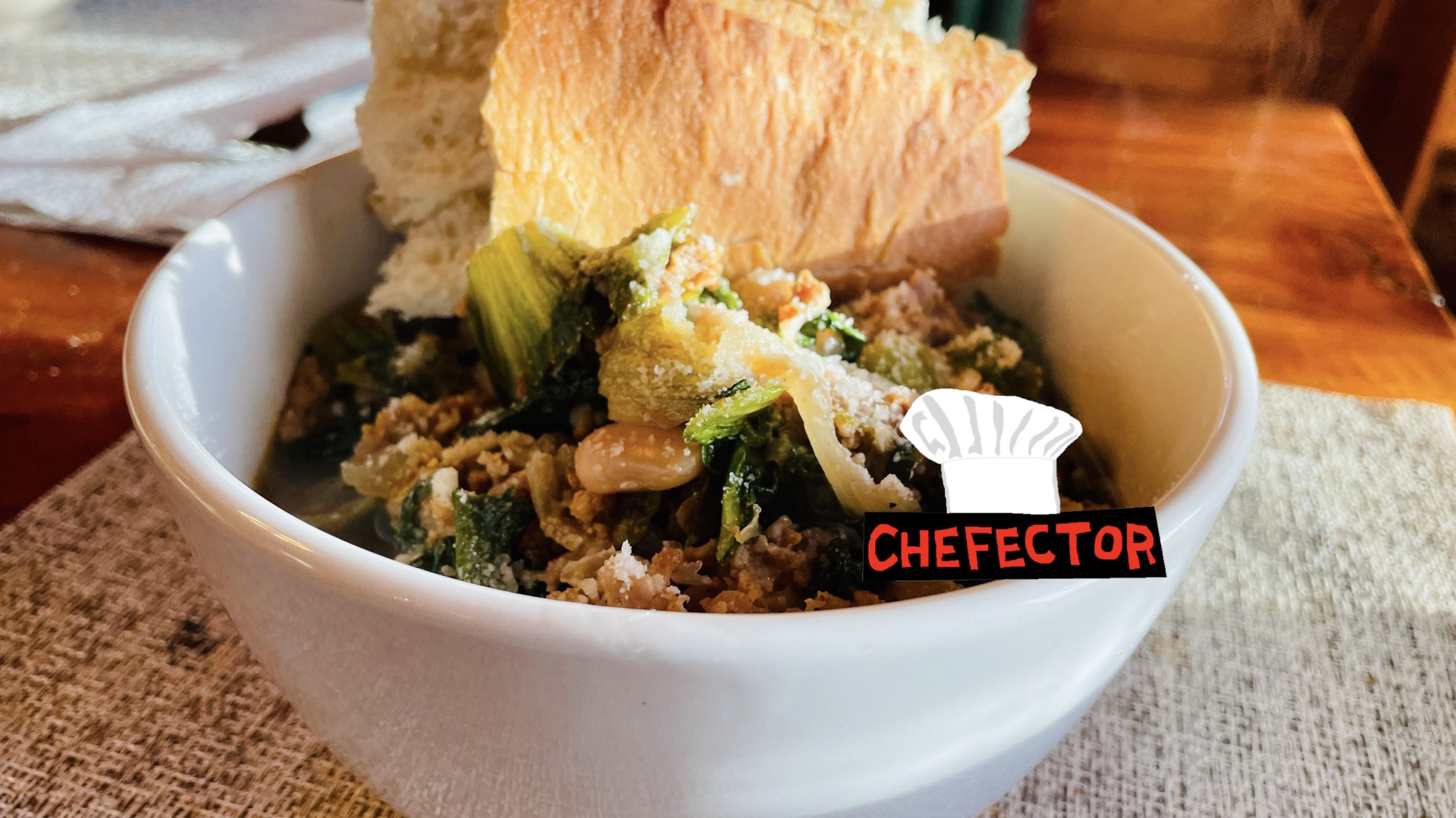I've learned not to trust what seems like autumn. Just about every year of the past decade we've gotten a sudden week of bright, dry, breezy, cool weather at some point in September or early October: The sunlight takes on the perfect unfiltered whiteness of having arrived where I am through air, only air, with nearly no dirty water suspended in it, and I go That's it, fall is here now, time to start wearing a sweater and cooking hearty autumn food. And then, every year, the week after that feels like what used to be July, and it goes on feeling like what used to be July until far too late in the year, late enough to be ominous. Then somebody flips a switch and it's suddenly winter.
That was this week, the sudden dry cool one. I don't really buy that this is fall, or maybe I don't buy that fall is an actual season that happens between summer and winter anymore, so much as it's a transient weather formation that arrives at some point in the back half of summer, for a week, and then yields the stage back to summer. I'm wearing corduroy pants and socks right now; I'll be surprised and at least a little bit relieved if it's not too hot for this for at least half of the days between now and Halloween.
Wait. How did I get sidetracked into climate doom? I'm sorry. That wasn't my intention. My intention was to be like, "Hey, it's almost fall outside now, so let's cook something hearty and warming and autumnal: Escarole with beans and sausage, a perfect autumn food!" That would have been a nice start to this blog. Let's pretend I did that.
Escarole with beans and sausage is, well, pretty much exactly what it sounds like. It's more-or-less a stew: Cooked escarole, cannellini beans, and crumbled Italian sausage, with enough flavorful broth that I can eat it with a spoon. Gently bitter from the escarole and fragrant with aromatics and fennel from the sausage, which I think of as autumn food, partly due, I'm sure, to some primitive impulse toward pre-hibernation weight gain, or anyway that will for sure be how I square it with my broader and seemingly contradictory goal of a more healthful lifestyle than any compatible with eating lots of Italian sausage. Also! It's one-pot cooking, which is just nice.
That's it. That's the sales pitch. Let's go.
Here are some things that you will need.
You will need some escarole. Escarole, for the unacquainted, is a type of endive, closely related to frisée and chicory, as well as to the pretty yellow candle-flame-shaped Belgian endive you might sometimes spot in the produce section of your local supermarket or green grocer. I don't think any of that is actually important knowledge for the purposes of cooking this stuff; it's just cool to know things about the food you eat. In any case, whole unchopped escarole looks like a big wild head of curly lettuce, pale green out at the tips, fading to a pretty, springy yellow down in the middle, and closer to white at the base. Its flavors are mild and pleasingly bitter; when chopped and cooked, as in Utica greens for example, or in what we're cooking today, its leaves, especially those down near the stem, retain some welcome fibrous character much more stubbornly than chard or spinach, but nowhere near as stubbornly as kale or collard greens. You get a nice moderate variety of both color and texture in the end, without having to simmer anything for hours. Escarole is a good cooking green.
A trait escarole shares with other cooking greens is that, once it's cooked, there's like one fifth as much of it as there was before you exposed it to heat. I really like stewed escarole—I like basically all stewed greens, for that matter—and I also, on a typical weeknight, have a solid handful of mouths to feed; when I last made escarole with beans and sausage, I used three vacuum-sealed bags of chopped escarole, equivalent to three heads of unchopped escarole, and it was great. I think if you use the proportions of ingredients that I will recommend in this blog, you will wind up with enough escarole with beans and sausage to serve as a hearty and filling main course for six people with reasonable grownup-sized appetites, possibly with second helpings, which you will want. If you are serving fewer than six people with reasonable grownup-sized appetites, or do not wish to do the busy-household thing of intentionally cooking enough to provide reheatable leftovers for the next day, then, ah, I guess you will want to use less escarole than that.
Definitely do not do the annoying finicky-eater thing of using as little escarole as you think you can get away with. The escarole is not a garnish here, nor is it in there for nutrition or color. It's the main damn ingredient! It's escarole with beans and sausage, not beans and sausage kinda streaked with green here and there.
Likewise: Back at the old website, in his extremely good instructions for making delicious Utica greens, our Chris Thompson offered that, in the event you couldn't find escarole, you could use chopped Romaine lettuce as a substitute. I suppose that holds with this stuff, too, at least in the sense that I don't know where you live and so cannot crash through your ceiling to stop you from using whatever you want in the food you cook for yourself, but I urge you to exhaust all reasonable channels for finding some escarole before you consider it. Romaine is a lovely and versatile salad and sandwich green, but can't hope to match either escarole's distinct (but not harsh!) bitter flavor or its fibrous bite. With apologies to beans and sausage, and the other ingredients we'll get to in a second, escarole is really what makes this dish. Find some dang escarole! And then, if it came in head form (rather than pre-chopped in a bag), chop it, crosswise, at roughly one-inch intervals from the stem end out to the tips of the leaves. Chuck the stem.
OK. Moving on. You will need some Italian sausage. I recommend the hot variety, and I recommend, oh, let's say two pounds of it, or a dozen links, whichever is more. If you can get it in uncased form, that's the move, otherwise you'll have to strip the casing off of it. (That's straightforward, if slightly gross: Make a slit up the side of a sausage with a sharp knife, then just peel the dang casing off it. There are other quicker ways to do it, involving squeezing, but they involve a higher risk of some of that delicious sausage getting trapped in the folds of the casing as you squeeze and never coming out.)
You'll need some cannellini beans. Let's say two cups of soaked, cooked, ready-to-eat beans. I recommend skipping to that bean-state by getting two cans of cannellini beans. If you want to use dry beans, you are going to have to find some other dang instructions. If you're using canned beans, empty them into a colander and run them under a cold tap for a minute to wash away the beany liquid from the can, then set them aside.
What else? Ah, right. You will need a big yellow onion, French-cut or diced as suits your preferences; let's say four big cloves of garlic, sliced thinly or minced; let's say an equal number of anchovy fillets, the kind that come packed in oil. You will need a couple glugs of olive oil plus, oh, probably around a quart of simmering liquid. This cooking liquid can be stock—chicken or beef or vegetable—or water. If it's water, it can be water with a lil' spoonful of dry bouillon power or it can be plain water. If it's plain water and you happen to have maybe a few glugs worth of cooking wine handy, maybe you can splash those in there in place of an equal amount of water for a little punch of flavor, or not. It'll be fine either way. It'll be fine!
You'll also need—need need need! Need! You will need—precisely three (3) pickled cherry peppers, chopped roughly, plus, oh, let's say a quarter-cup of the tart brine they came in, in a separate cup or ramekin or ashtray or whatever from the peppers. I don't make the rules! This is just the right way to do it. I'm sorry, but you simply must acquire a jar of pickled cherry peppers for this. You will need salt and pepper. I'm gonna go ahead and say that you'll need some grated hard Italian cheese; this can be the familiar Parmigiano-Reggiano or it can be a sharper pecorino. And you'll need a loaf of crusty bread. I'm pretty sure that's it. Let's find out!
As for non-food stuff, you'll need a big heavy pot or Dutch oven. You'll need a trusty cooking implement, like a wooden spoon (best) or flexible silicone spatula (also fine) or (look, it's really none of my business) hastily repurposed Skeletor action figure. It'll be great if this implement is slotted, so that later you can remove hot sausage from the pot without also removing any more of its rendered fat than absolutely necessary, but you will do fine even if it isn't. You'll need a big bowl. I feel that telling you that you will need a working stovetop and oven would be an insult to your intelligence, and therefore will not. Let's cook now.
Preheat your oven to 400 degrees. This is just so that later you can stick the loaf of crusty bread in there for six minutes to get it all hot and crackly. Heat up your pot or Dutch oven over a medium-high stovetop burner.
When the pot's hot as hell, pour that couple of glugs of olive oil in there and start browning your uncased sausage in it. You can do this one of two ways: You can chuck all the sausage in there and move it around and break it up—not too tiny! You want at least some nice hearty chunks in your food, even if you think you do not—with your implement as it cooks, and then when it's, let's be realistic here, grey in hue and cooked through remove it to the big bowl, leaving as much of the rendered fat behind in the pot as you can. Or, you can work in small batches—so that there's enough space between individual wads of sausage for their liquid to evaporate and so that you can get some real, actual browning into the meat—removing each batch to the bowl only after it has acquired at least a little bit of real-deal crispy brownness here and there.
The latter approach will yield both tastier and better-looking bites of sausage; also, you'll get more hot stuff caked onto the bottom of the pot this way, and when you deglaze it later you'll get tastier liquid out of scraping that stuff off the pot. On the other hand, it takes quite a bit longer, and your escarole with beans and sausage is going to taste great even if you take the quicker route. Decide for yourself! I promise it'll be fine either way.
So you've got a big bowl filled with hot sausage, and a pot featuring no small quantity of just extremely fucking exciting rendered sausage fat. (The "exciting" part of the previous sentence will be especially true if you followed my earlier recommendation of hot Italian sausage; the fat will be a vivid orange color suggestive of the smooth heat it's going to impart to the entire finished product. Oh hell yeah.) Chuck your onions into this glorious substance and move them around with your implement; sprinkle them with a pinch of salt to help them work up a sweat as they cook. In, oh, 10 or 15 minutes they'll be softened and sweetened and largely translucent. Pitch the 'chovies in there and move things around for a minute or so until the fish has dissolved. When it has, in go the garlic and the cherry peppers (but not the brine!).
Within a few seconds you should be able to smell the garlic heating up; give it another 30 seconds of moving things around with the cooking utensil. By now, between whatever cooked into the bottom of the pot off the sausage, plus however much dissolved anchovy has sizzled into place, you've likely got some amount of hot dark crud coating some or all of the bottom of the pot. Pour in the cooking liquid and get busy scraping the bottom of the pot with the spoon or spatula or Skeletor. The brown stuff should come off without too much resistance. That was deglazing; it made the liquid taste better. Let the liquid come up to a bubbling simmer, then taste it. Does it need salt? It probably does. Add some salt. Taste it again. That's better, yeah? Nice. Grind some pepper in there, too. (Yes, you're allowed to taste it again.)
Now, working in big handfuls, add the escarole to the pot, gently stirring and tossing things as you go so that all the escarole in a given handful gets a nice full dousing in that hot liquid and begins to wilt (i.e. to take up less space) and is mixed together with the pot's other contents before you add the next handful. This'll take a couple of minutes. No, please, go right ahead. I'm not busy at all. It's not like I could be doing anything with my Saturday other than standing here watching you cook.
Escarole all wilted and stirred in there? Great. Return the sausage (plus any liquid in the bowl) to the pot and fold it back in there real good. And hey, while you're gently folding things into the food in the pot, go ahead and dump the beans in there too. Fold them in, as if that wasn't freaking obvious!!! And, lastly, stir in the little quarter-cup of vinegary pepper brine.
Oh, right, I nearly forgot: You're about six minutes from eating, so chuck the loaf of bread into the 400-degree oven and set a timer for six minutes.
The sausage was already cooked when you added it back to the pot; the beans were already cooked when they came out of the can. This stuff just needs a minute to heat back up after the jolt of having lukewarm sausage and beans dumped into it. When it's there, it's time to eat. It's time to friggin' eat.
Ladle this stuff into bowls, making sure to get plenty of the liquid into each; remember, this is Spoon Food. Sprinkle some of the grated cheese over each bowl; also, each bowl—steamy and fragrant and luscious with silky stewed greens and alluring pork grease, oh man oh man oh man—gets a nice hand-torn hunk of the hot crusty bread, for dredging through the liquid or heaping with hot escarole and sausage and beans and wolfing down like a damn maniac. You can handle that part, so I will leave you to it.






